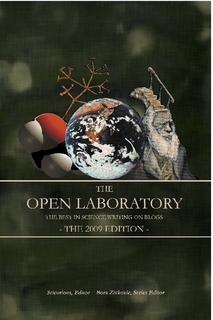There are 25 new articles in PLoS ONE today. As always, you should rate the articles, post notes and comments and send trackbacks when you blog about the papers. You can now also easily place articles on various social services (CiteULike, Mendeley, Connotea, Stumbleupon, Facebook and Digg) with just one click. Here are my own picks for the week - you go and look for your own favourites:
Increased Health Risk in Subjects with High Self-Reported Seasonality:
Seasonal variations in mood and behaviour, termed seasonality, are commonly reported in the general population. As a part of a large cross-sectional health survey in Hordaland, Norway, we investigated the relationship between seasonality, objective health measurements and health behaviours. A total of 11,545 subjects between 40-44 years old participated, completing the Global Seasonality Score, measuring seasonality. Waist/hip circumference, BMI and blood pressure were measured, and blood samples were analyzed for total cholesterol, HDL cholesterol, triglycerides and glucose. Subjects also completed a questionnaire on miscellaneous health behaviours (exercise, smoking, alcohol consumption). Hierarchical linear regression analyses were used to investigate associations between seasonality and objective health measurements, while binary logistic regression was used for analysing associations between seasonality and health behaviours. Analyses were adjusted for sociodemographic factors, month of questionnaire completion and sleep duration. Seasonality was positively associated with high waist-hip-ratio, BMI, triglyceride levels, and in men high total cholesterol. Seasonality was negatively associated with HDL cholesterol. In women seasonality was negatively associated with prevalence of exercise and positively associated with daily cigarette smoking. High seasonality was associated with objective health risk factors and in women also with health behaviours associated with an increased risk for cardiovascular disease.
Tardigrades are small, multicellular invertebrates which are able to survive times of unfavourable environmental conditions using their well-known capability to undergo cryptobiosis at any stage of their life cycle. Milnesium tardigradum has become a powerful model system for the analysis of cryptobiosis. While some genetic information is already available for Milnesium tardigradum the proteome is still to be discovered. Here we present to the best of our knowledge the first comprehensive study of Milnesium tardigradum on the protein level. To establish a proteome reference map we developed optimized protocols for protein extraction from tardigrades in the active state and for separation of proteins by high resolution two-dimensional gel electrophoresis. Since only limited sequence information of M. tardigradum on the genome and gene expression level is available to date in public databases we initiated in parallel a tardigrade EST sequencing project to allow for protein identification by electrospray ionization tandem mass spectrometry. 271 out of 606 analyzed protein spots could be identified by searching against the publicly available NCBInr database as well as our newly established tardigrade protein database corresponding to 144 unique proteins. Another 150 spots could be identified in the tardigrade clustered EST database corresponding to 36 unique contigs and ESTs. Proteins with annotated function were further categorized in more detail by their molecular function, biological process and cellular component. For the proteins of unknown function more information could be obtained by performing a protein domain annotation analysis. Our results include proteins like protein member of different heat shock protein families and LEA group 3, which might play important roles in surviving extreme conditions. The proteome reference map of Milnesium tardigradum provides the basis for further studies in order to identify and characterize the biochemical mechanisms of tolerance to extreme desiccation. The optimized proteomics workflow will enable application of sensitive quantification techniques to detect differences in protein expression, which are characteristic of the active and anhydrobiotic states of tardigrades.
The Influence of Modularity on Cranial Morphological Disparity in Carnivora and Primates (Mammalia):
Although variation provides the raw material for natural selection and evolution, few empirical data exist about the factors controlling morphological variation. Because developmental constraints on variation are expected to act by influencing trait correlations, studies of modularity offer promising approaches that quantify and summarize patterns of trait relationships. Modules, highly-correlated and semi-autonomous sets of traits, are observed at many levels of biological organization, from genes to colonies. The evolutionary significance of modularity is considerable, with potential effects including constraining the variation of individual traits, circumventing pleiotropy and canalization, and facilitating the transformation of functional structures. Despite these important consequences, there has been little empirical study of how modularity influences morphological evolution on a macroevolutionary scale. Here, we conduct the first morphometric analysis of modularity and disparity in two clades of placental mammals, Primates and Carnivora, and test if trait integration within modules constrains or facilitates morphological evolution. We used both randomization methods and direct comparisons of landmark variance to compare disparity in the six cranial modules identified in previous studies. The cranial base, a highly-integrated module, showed significantly low disparity in Primates and low landmark variance in both Primates and Carnivora. The vault, zygomatic-pterygoid and orbit modules, characterized by low trait integration, displayed significantly high disparity within Carnivora. 14 of 24 results from analyses of disparity show no significant relationship between module integration and morphological disparity. Of the ten significant or marginally significant results, eight support the hypothesis that integration within modules constrains morphological evolution in the placental skull. Only the molar module, a highly-integrated and functionally important module, showed significantly high disparity in Carnivora, in support of the facilitation hypothesis. This analysis of within-module disparity suggested that strong integration of traits had little influence on morphological evolution over large time scales. However, where significant results were found, the primary effect of strong integration of traits was to constrain morphological variation. Thus, within Primates and Carnivora, there was some support for the hypothesis that integration of traits within cranial modules limits morphological evolution, presumably by limiting the variation of individual traits.
The Audiovisual Tau Effect in Infancy:
Perceived spatial intervals between successive flashes can be distorted by varying the temporal intervals between them (the "tau effect"). A previous study showed that a tau effect for visual flashes could be induced when they were accompanied by auditory beeps with varied temporal intervals (an audiovisual tau effect). We conducted two experiments to investigate whether the audiovisual tau effect occurs in infancy. Forty-eight infants aged 5-8 months took part in this study. In Experiment 1, infants were familiarized with audiovisual stimuli consisting of three pairs of two flashes and three beeps. The onsets of the first and third pairs of flashes were respectively matched to those of the first and third beeps. The onset of the second pair of flashes was separated from that of the second beep by 150 ms. Following the familiarization phase, infants were exposed to a test stimulus composed of two vertical arrays of three static flashes with different spatial intervals. We hypothesized that if the audiovisual tau effect occurred in infancy then infants would preferentially look at the flash array with spatial intervals that would be expected to be different from the perceived spatial intervals between flashes they were exposed to in the familiarization phase. The results of Experiment 1 supported this hypothesis. In Experiment 2, the first and third beeps were removed from the familiarization stimuli, resulting in the disappearance of the audiovisual tau effect. This indicates that the modulation of temporal intervals among flashes by beeps was essential for the audiovisual tau effect to occur (Experiment 2). These results suggest that the cross-modal processing that underlies the audiovisual tau effect occurs even in early infancy. In particular, the results indicate that audiovisual modulation of temporal intervals emerges by 5-8 months of age.
Open Space Loss and Land Inequality in United States' Cities, 1990-2000:
Urban growth reduces open space in and around cities, impacting biodiversity and ecosystem services. Using land-cover and population data, we examined land consumption and open space loss between 1990 and 2000 for all 274 metropolitan areas in the contiguous United States. Nationally, 1.4 million ha of open space was lost, and the amount lost in a given city was correlated with population growth (r(272) = 0.85, P<0.001). In 2000, cities varied in per capita land consumption by an order of magnitude, from 459 m2/person in New York to 5393 m2/person in Grand Forks, ND. The per capita land consumption (m2/person) of most cities decreased on average over the decade from 1,564 to 1,454 m 2/person, but there was substantial regional variation and some cities even increased. Cities with greater conservation funding or more reform-minded zoning tended to decrease in per capita land consumption more than other cities. The majority of developed area in cities is in low-density neighborhoods housing a small proportion of urban residents, with Gini coefficients that quantify this developed land inequality averaging 0.63. Our results suggest conservation funding and reform-minded zoning decrease per capita open space loss.
We propose a formal language that allows for transposing biological information precisely and rigorously into machine-readable information. This language, which we call Zsyntax (where Z stands for the Greek word ζωή, life), is grounded on a particular type of non-classical logic, and it can be used to write algorithms and computer programs. We present it as a first step towards a comprehensive formal language for molecular biology in which any biological process can be written and analyzed as a sort of logical "deduction". Moreover, we illustrate the potential value of this language, both in the field of text mining and in that of biological prediction.
Previous studies investigated the neural and molecular underpinnings of the tingle sensation evoked by sanshool and other natural or synthetic alkylamides. Currently, we sought to characterize the psychophysical properties associated with administration of these compounds. Like other chemesthetic stimuli, the synthetic tingle analog isobutylalkylamide (IBA) evoked a sensation that was temporally dynamic. Repeated IBA application at short (30 sec) interstimulus intervals (ISI) resulted in a tingle sensation that increased across trials. Application at longer ISIs (~30 min) resulted in a sensation of decreased intensity consistent with self-desensitization. Prior treatment with the TRPV1 or TRPA1 agonists, capsaicin and mustard oil did not cross-desensitize the tingle sensation evoked by IBA suggesting that neither TRPV1 nor TRPA1 participate in the transduction mechanism sub-serving tingle. When evaluated over 30-min time period, lingual IBA evoked a sensation that was described initially as tingling and pungent but after approximately 15 min, as a cooling sensation. Further, we found that the sensation evoked by lingual IBA was potentiated by simultaneous application of cold (0°C) and cool (21°C) thermal stimuli but was unaffected by warm (33°C) and hot (41°C) temperatures. Finally, to test the hypothesis that the tingling sensation is subserved by the activation of mechanosensitve fibers, we evaluated lingual tactile thresholds in the presence and absence of lingual IBA. The presence of IBA significantly raised lingual tactile thresholds, whereas capsaicin did not, identifying a role for mechanosensitive fibers in conveying the tingle sensation evoked by sanshool-like compounds. Collectively, these results show that lingual alkylamide evokes a complex sensation that is temporally dynamic and consistent with in vitro and in vivo experiments suggesting these compounds activate mechanosensitve neurons via blockade of KCNK two-pore potassium channels to induce the novel tingling sensation.
There have been many changes in clinical trials methodology since the introduction of lithium and the beginning of the modern era of psychopharmacology in 1949. The nature and importance of these changes have not been fully addressed to date. As methodological flaws in trials can lead to false-negative or false-positive results, the objective of our study was to evaluate the impact of methodological changes in psychopharmacology clinical research over the past 60 years. We performed a systematic review from 1949 to 2009 on MEDLINE and Web of Science electronic databases, and a hand search of high impact journals on studies of seven major drugs (chlorpromazine, clozapine, risperidone, lithium, fluoxetine and lamotrigine). All controlled studies published 100 months after the first trial were included. Ninety-one studies met our inclusion criteria. We analyzed the major changes in abstract reporting, study design, participants' assessment and enrollment, methodology and statistical analysis. Our results showed that the methodology of psychiatric clinical trials changed substantially, with quality gains in abstract reporting, results reporting, and statistical methodology. Recent trials use more informed consent, periods of washout, intention-to-treat approach and parametric tests. Placebo use remains high and unchanged over time. Clinical trial quality of psychopharmacological studies has changed significantly in most of the aspects we analyzed. There was significant improvement in quality reporting and internal validity. These changes have increased study efficiency; however, there is room for improvement in some aspects such as rating scales, diagnostic criteria and better trial reporting. Therefore, despite the advancements observed, there are still several areas that can be improved in psychopharmacology clinical trials.













